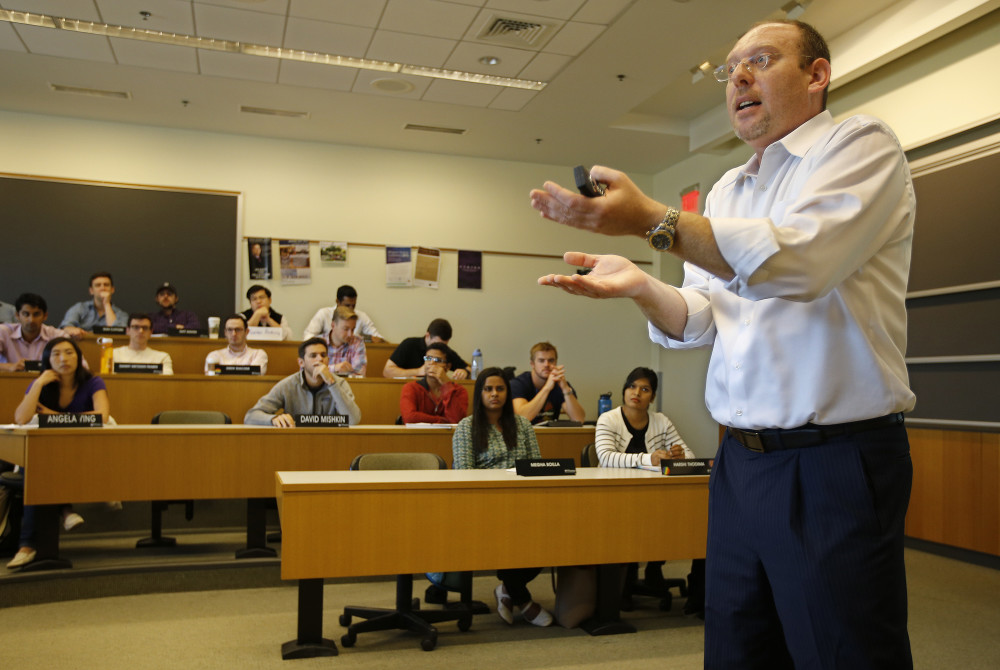By Jane M. Von Bergen
The Philadelphia Inquirer.
PHILADELPHIA
I’m sitting here trying to write the first paragraphs for this article, and the pressure is on.
The story is about a University of Pennsylvania professor who teaches creativity, for God’s sake, meaning I’d better come up with something creative or he will think I’m dull.
Worse, my readers will quit this story and turn to a report about some sports team that wears green jerseys.
Wouldn’t it be great if there were a proven method I could use to alleviate my anxiety and devise something creative, other than the traditional techniques of lining my paper clips up by size, biting my nails and drinking coffee?
Something outside the box …
Ah, but that’s the problem, says Rom Schrift, a mechanical engineer turned marketing professor who teaches Marketing 292 to finance types at the Wharton School of the University of Pennsylvania.
Stop trying to escape the box. Instead, embrace it, he advises. “We’ll think inside the box,” Schrift told Wharton graduate students at the first class. “If there’s a box, we’ll use the box.”
Constraints, procedures, templates, spreadsheets, forecasting boxes, attributes, components, these are actually systems to funnel thoughts in ways that are more likely to lead to creative solutions.
Schrift talked about an author boxed in by a challenge to write a children’s book using 50 different words or less. The result, “Green Eggs and Ham” by Dr. Seuss, is one of the top-selling children’s books of all time.
“Maybe there’s a sweet spot where we can actually use constraints in a way that will actually help us,” Schrift told the class.
“There is a systematic approach to creativity,” he said. An analysis of the underlying structure of an idea, or a product, can then reveal places where creativity can occur.
“It doesn’t matter what you do in any business activity, you’ll be able to implement these ideas,” he said, adding later that these processes particularly appeal to engineering types like himself.
What are these systematic approaches?
There’s a semester of material, but some fairly accessible first steps exist. They have to do with considering the relationship of the attributes of a product, or a problem.
Imagine changing a simple drinking glass.
The glass has height, diameter, transparency, heat conductivity, all attributes inherent to the glass. It might hold beer or coffee, hot liquids or cold, be used by an adult or a child. Those attributes are external.
Now imagine a spreadsheet. Internal attributes head columns. Internal and external attributes define rows. Each box represents a place where two attributes intersect.
So, imagine if you widen the diameter in relationship to the height. You might have a vessel with a wider bottom, something more stable, less likely to spill. Or imagine if you bring the diameter to nothing at the bottom, but increase it at the top.
That produces one of those throw-away paper cups found in bathrooms, or an ice cream cone.
By systematically moving through each relationship on the grid, a problem solver may encounter a relationship that yields a new idea, or allows one to be eliminated.
Another accessible step is understanding the power of templates and using them in new ways.
Consider, for example, the blues, where the same chord template has produced decades of different songs.
Or, in marketing, where “gross exaggeration” is a template used in many advertisements.
In class, Schrift showed an advertisement for a vacuum cleaner.
People want vacuum cleaners with powerful suction abilities, that’s an important component. Analyzing for components is a key part of the process, followed by the application of template.
In the advertisement, a row of goose hunters lined up, aiming their weapons upward. The hunters with rifles had no luck, but the hunter armed with a vacuum sucked his goose right out of the sky, an obvious exaggeration, and gross.
Schrift tells me that many people, not just me, are anxious about creativity. They think creativity is somehow genetic, “you either have it or you don’t,” yet, at the same time, creativity is highly valued.
And for people, such as mechanical engineers who prefer to turn everything into a process, even creativity, the approach provides hope, he said.
That’s what appealed to Jennifer Engel, 27, who worked in wealth management before returning to Penn for her master’s in business administration.
“I don’t think I’m a very creative person,” she said, “so coming up with a systematic approach will help me solve problems in a creative way.”
And now, how to end creatively?
When I think, I use the box.
I use the box, not a lox.
I use the box, not Botox.
Outside the box, I am a pox.
Inside the box, I am a fox.
So in, not out, I use a box.
The End.














































































































































































































































































































































































